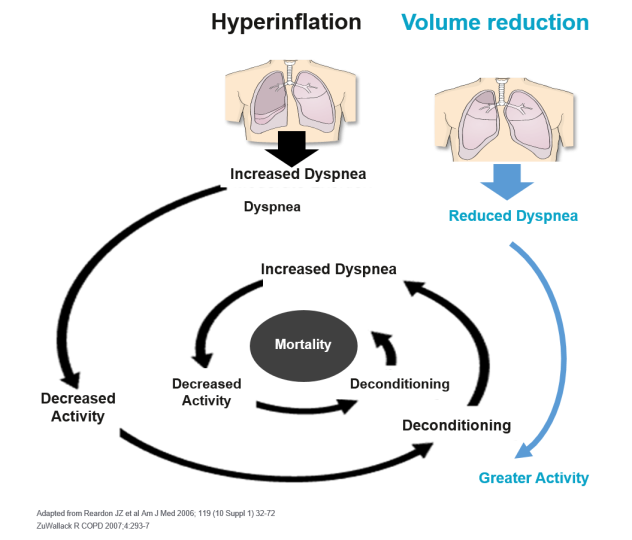What Is Emphysema?
Emphysema is a form of chronic obstructive pulmonary disease (COPD) that is characterized by destruction of lung tissue and formation of blebs, which results in impaired gas exchange and abnormal increase in the amount of lung volume trapped in the chest. Also known as hyperinflation, this excessive degree of air build up places respiratory muscles at a mechanical disadvantage leading to progressive shortness of breath. Lung volume reduction procedure aims to stop the vicious cycle of breathlessness caused by hyperinflation.

Figure 2: Vicious cycle of breathlessness caused by hyperinflation.
What Is Bronchoscopic Lung Volume Reduction?
Bronchoscopic or endobronchial volume reduction is a novel FDA approved procedure for selected patients with severe emphysema and hyperinflation. Procedure involves insertion of one way valves into most disease affected lobe, thereby allowing air to exit but not re-enter. This leads to volume reduction in the treated portion of the lung, improvement in symptoms and an increase in pulmonary function. Patients are able to walk further, perform more activities of daily living and some are even able to get off oxygen.
- Less shortness of breath
- Better exercise tolerance
- Improvement in walking/climbing stairs and carrying out other activities of daily living
- Less need for Prednisone
- Less oxygen requirement
- Improvement in lung function on pulmonary fuction testing
Unlike surgical lung volume reduction, endobronchial valves are performed exclusively through a bronchoscope (flexible fiberoptic camera) without any need for surgical intervention, stitches or scars. This offers additional treatment options for patients with compromised respiratory status who are unfit for surgery. Patients who are candidates for lung volume reduction but cannot undergo endobronchial valve placement are offered surgical lung volume reduction procedure using minimally invasive surgical techniques.

Dr. Eugene Shostak is a board certified interventional pulmonologist with expertise in lung volume reduction procedure. He was involved in some of earlier lung volume reduction trials and performs a high number of endobronchial lung volume reduction procedures in New York City. Our valve program at Weill Cornell Medicine is one of the busiest, if not the busiest, programs in NYC.
What sets our program apart
Multidisciplinary Team of Experts
The Lung Volume Reduction Program at Weill Cornell Medicine comprises of a multidisciplinary team of experts who share their clinical expertise in providing the patient the best possible recommendation and treatment plan. Whether it is valves for bronchoscopic lung volume reduction, a minimally invasive lung volume reduction surgery, or referral for lung transplantation, patients who come to our program are guaranteed to receive highest level of care and personalized treatment approach.
Click here to learn more about the Multidisciplinary Team of Experts

A thorough assessment of anatomy to predict the best procedural results
“We routinely perform intraprocedural assessment of collateral ventilation” says Dr. Shostak. “This helps us better select patients who may otherwise have not been offered a procedure if the selection was based on CT chest alone”.
Access to both Spiration and Zephyr valves
“We are one of the very few programs in the country that use both Spiration and Zephyr valves during the same case” says Dr. Shostak. “Having access to both products allows me to better tailor the procedure to individual patients anatomy which in turn results in better patient outcomes.”
Options For Both Endoscopic and Surgical Lung Volume Reduction Procedures
Patients who are not candidates for valve procedure may be candidates for surgical lung volume reduction. Our center has experience performing these procedures using minimally invasive techniques.
Proof of Efficacy
In several large clinical trials, patients treated with endobronchial lung volume reduction enjoyed improvement in lung function and quality of life compared with control group.



